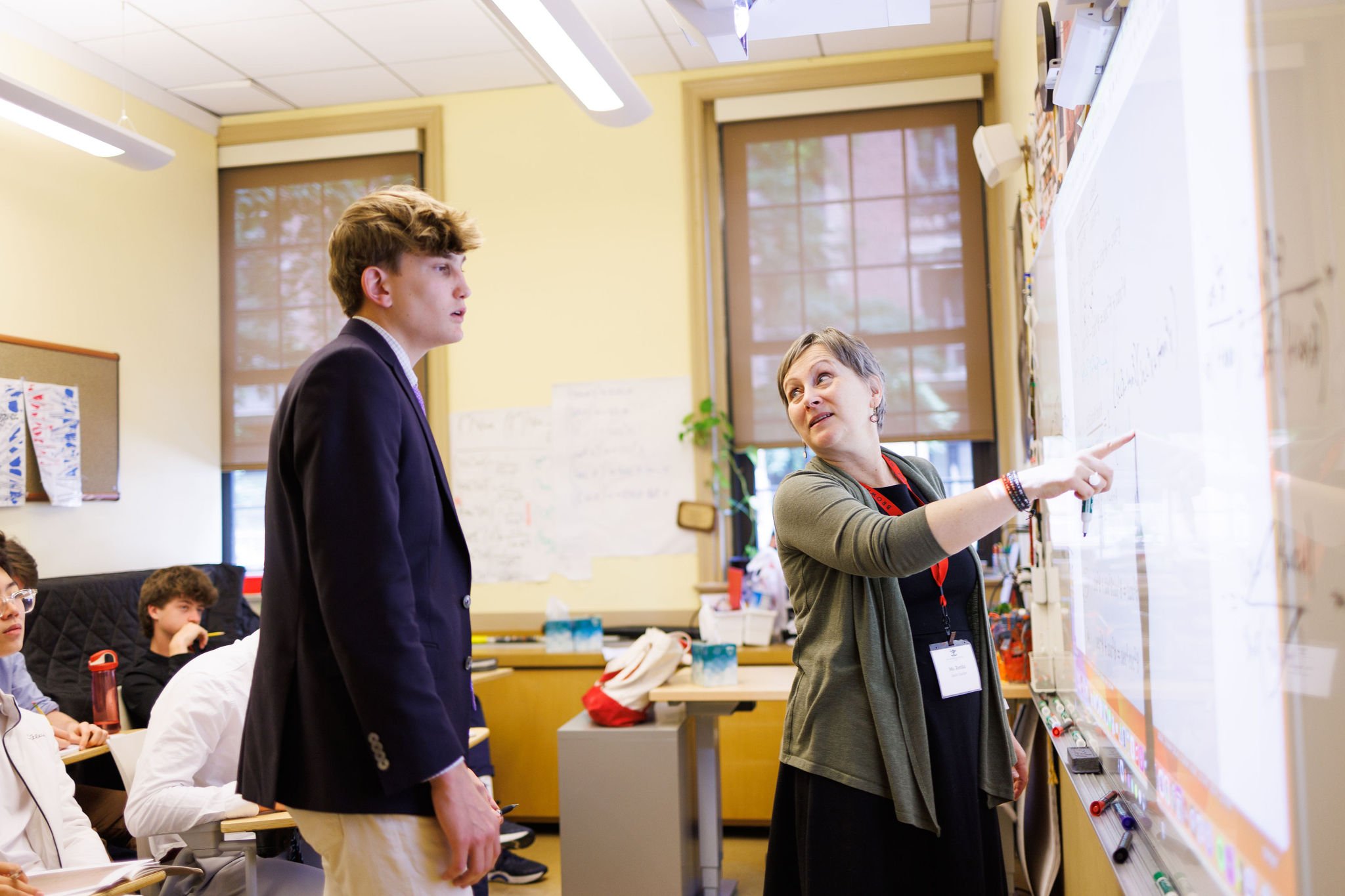
Target-Focused Teaching
Target-Focused Teaching (TFT) is Browning’s unique way of ensuring deep learning in all boys. Composed of four, research-supported elements for deep learning, TFT ensures that our boys experience a rich curriculum that builds life-long knowledge and skills.
The four elements are:
Using the full range of rigor defined by Webb’s Depth of Knowledge scale—a vocabulary and frame of reference for levels of engagement with content
Articulating learning targets
Using formative and summative assessments
Designing cycles of feedback and reflection
What is Depth of Knowledge?
In order to learn deeply and lastingly, we believe that a student needs both foundational knowledge and the ability to apply that knowledge beyond school.
In order to do so, boys must experience learning that travels through all four levels of Depth of Knowledge. For example, we do care about teaching the dates and facts that are learned in a traditional history classroom—even if they can be looked up online—because we believe having a command of that content within one’s own head allows a boy to feel both proud of his knowledge and form new lines of inquiry of his own.
Level 1 - Recalling important information and using algorithmic procedures
Level 2- Organizing information and using problem-solving to find a solution
Level 3- Explaining, justifying, or drawing conclusions
Level 4- Sustaining complex thinking and making connections among disparate ideas and within new or unfamiliar situations
History Example:
Foundational knowledge - memorizing dates and events (DoK Level 1)
Tool - using Google Earth app to create a geography-based timeline (DoK Levels 2 and 3
Transferable Skill - Evaluating to what extent one event impacted another (DoK Levels 3 and 4)
What are learning targets?
Learning targets are the compass of our curriculum. They articulate where a student is trying to go in his learning. Our learning targets are written in three tiers:
-
What we are trying to teach across our K-12 curriculum
-
The skills and content we teach in a specific grade or course
-
The immediate content necessary for a specific lesson.
What motivates boys?
The true benefit of using the four elements of Target-Focused Teaching is increased motivation for boys.
When a boy is motivated to learn because of the clear structure of his academic program, the relationships he has developed, and the nature of his assignments, then there is no stopping what he can do in this world.
-
Grades
Parental Praise
Teacher Praise
Authentic audience (impress others)
Exemplars (exemplary examples)
School values
-
Personal interest
Connection to peers or teacher
Authentic audience (validation of and pride in one's expertise)
Observable growth
Fun & joy
What does assessment look like?
At Browning, we use a variety of assessments to determine whether a student has reached proficiency in a learning target. Tests, papers, quizzes, performances, interviews, presentations, process portfolios, lab papers, and discussions are all forms of assessment.
The two categories of assessment we use to determine whether a student has reached proficiency in a learning target are:
-
Used to give feedback about learning so a student and teacher both know what to do next
-
Used to determine the level of proficiency a student has attained on one or more learning targets and often include a grade
What are Cycles of Feedback?
Cycles of feedback are the hallmark of the Browning program. We give students learning targets and learning experiences, and then we give them feedback on how well their work met the target. The feedback is the catalyst for the student knowing what to do next in his learning. Often feedback is given in the form of a rubric and comment that shows where a student should focus his learning.
The Eight Dimensions of Boys’ Learning
Boys come to Browning to be known, challenged, and inspired. When a boy’s capacities and aspirations are known and understood by his teachers, that boy can be guided, year after year, to take increasing ownership of his learning. He will develop the disposition not only to respond to others’ questions, but also the ability to craft questions of his own, questions that will drive his class’ process of inquiry. Through this activity, the boys are likewise challenged to ask similar searching questions of themselves. It is through this questioning that they come to understand their identities as intellectual and moral agents, and recognize the opportunities they have to develop and refine their senses of self and character. In reflecting upon the bigger, essential questions that arise from their self-examination and academic work, Browning boys are inspired to seek a deeper level of understanding and to build a sense of purpose that will engage their passions and skills in the service of the world beyond themselves.
Relationships
At Browning this means
Boys are relational learners. When the relationship between a boy and a teacher is strong—when the boy feels known, appreciated, and trusted—the boy is not only more engaged in his studies, but also more inspired to pursue future learning. These claims are substantiated not only through scholarly research, but also by what our boys report about their deep and lasting relationships with teachers and peers.
Agency
At browning this means
We intentionally cultivate learning experiences that allow boys to construct knowledge and meaning. Rather than transmitting knowledge to passive consumers, we craft lessons and activities that put essential questions, student voices, and collaboration at the center, and invite boys to be active contributors to the discipline.
Inquiry
At Browning this means
Inquiry is the heart of learning, and we teach boys at Browning to pursue big problems, craft meaningful questions, discover ideas, and actively perform understanding in a public manner.
Identity
At browning this means
Education is built on an understanding of the self. We ask the boys to develop their individual narratives and an understanding of who they are and what constitutes a good life for them. As the boys begin to know themselves, they enhance their capacity to understand and appreciate others and themselves and to take action to improve our world.
Understanding
At browning this means
Understanding is the end result of the process of inquiry. The ultimate goal of student-directed inquiry is not mere content knowledge, but mastery of how to use, appreciate, and build upon that knowledge. Understanding sparks further curiosity and reignites the process of inquiry, leading to a lifetime of learning.
Character
At browning this means
Our capacity to live well with others largely determines who we are in the world; how we treat others shapes how we are seen and understood. We aspire to always be the best versions of ourselves through the expression of honesty, compassion, and respect for others. Our community commits to learning from mistakes and practicing forgiveness when our best efforts fall short.
Purpose
At browning this means
Boys are encouraged to find their passion and to pursue a course of action that will allow them to engage this passion in service of their learning, their communities, and the world at large. Students who have discovered a sense of purpose have “a stable and generalized intention to accomplish something that is at the same time meaningful to the self and consequential for the world beyond the self. … [They have] identified something that matters to them, know why it matters to them, and are currently working on that issue with a long-term plan for future action” (William Damon).
Reflection
At browning this means
Reflection involves meditation not only on recent learning, but also the manner in which that learning was acquired. This exercise allows boys to find greater meaning in their learning experiences; indeed, when our boys reflect, they both produce greater connection to new knowledge and find a deeper understanding of their own learning process.
The Browning Learning System
The Browning Learning System, used by students in Grade 3 through 12 provides students with evidence-based tools that allow them to grow from dependent to independent learners.
-
Survey, question (and link), read, recite, review—is an evidence-based reading and study technique that encourages active engagement with the material, and helps improve comprehension and retention. From the initial 'survey' of the material--scanning for the headings, subheadings and images that help put the reading in context--through 'review,' this method ensures that boys more deeply understand what they are learning through making connections.
-
An active note making system where students are taught to divide a page into three sections—a skinny left column, a wider right column, and a section that runs across the bottom of the page. On the left, a student writes cues or questions, while the right is reserved for the bulk of the notes and the bottom for a summary section where the student will consolidate the main points of the lesson. It allows them to capture information consistently and to use their notes for studying.
-
To be used across all disciplines, these provide for quicker notetaking and so that notes can be easily shared among students.
-
A method for keeping track of items using a color-coding technique for each discipline:
English – RED
Math – BLUE
Science – GREEN
History – YELLOW
Spanish/French – ORANGE
Latin/Greek – PINK
CSE – AQUA
Performing and Fine Arts – PURPLE
-
A Browning signature executive function planner that allows students to keep track of assignments, including marking when they are complete, and planning ahead for weekend homework.











